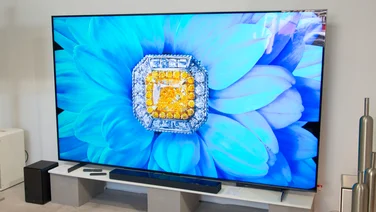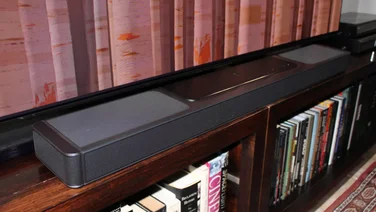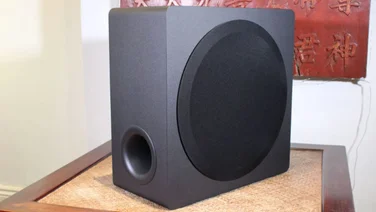To help us provide you with free impartial advice, we may earn a commission if you buy through links on our site. Learn more





While most TV manufacturers have focused on adding a third dimension to their 2010 TV ranges, Sharp chose to buck the trend and go in a different direction by introducing its Quad Pixel technology. This adds a fourth, yellow, sub-pixel to the traditional red, green and blue ones found in every colour TV released to date.
It’s a curious decision to make given the hype surrounding 3D after its success at the box office and it’s one that could get lost in the rest of the industry’s marketing push. If it does, that’d be a huge shame, because while Quad Pixel technology doesn’t sound particularly significant, it could be the biggest fundamental change to TVs since colour broadcasts were first introduced.

It promises to increase the colour palette available by a factor of 1,000, enabling more accurate colours across the whole range. In particular, it means yellows (or mustards, golds and other derivatives) should look more natural, as they’ll no longer need to be a combination of red, green and blue. What’s more, Sharp’s new technology could also help circumvent one of the biggest problems with today’s 3DTVs too – poor colour saturation – but we’re getting ahead of ourselves there as the Aquos LC-46LE821E doesn’t support 3D.

Changing the way colour images are produced is not as simple as adding an extra sub-pixel into the fray and it’s actually rather difficult to do, which explains why nobody else has come up with the idea before. In fact, Sharp claims that it took the company four years of R&D work to come up with the answer.
The LC-46LE821E is a great-looking TV – one of the nicest we’ve seen – but the base is a little flimsy and didn’t feel as firm as we’d hope. Its slender figure – it’s just 39mm thick – makes it ideal for wall mounting, though. Along the bottom edge, there’s an angled strip of highly polished metal overlaid with an illuminated Sharp logo in the left corner, the Aquos triangle in the middle and a selection of touch-sensitive controls in right corner, which light up upon interaction.
Speaking of the controls, Sharp has also redesigned its remote control and it’s a big improvement over previous zappers. It’s now slim, stylish and the buttons have a much more intuitive layout unlike its previous remotes.
We were suitably impressed by what’s served up when we checked out the LE821’s connections. Alongside a collection of four HDMI sockets, there’s an RS232C control port that allows you to use your TV as part of a home-automation setup, a USB socket for playing video (including HD) and photos back. It’s rounded off with an Ethernet connector for internet connectivity, but Sharp doesn’t offer any web-connected services like its rivals. Instead, the Ethernet port can be used to access media stored on a DLNA-enabled PC or network storage device. In the future, it could be used for potential Freeview HD interactive services.
The 46LE821E uses an edge-lit LED backlight, which delivered good contrast and reasonable blacks, but we saw evidence of ever-so-slightly uneven backlighting. Most of the time, this wasn’t a huge problem, but it did prove a little frustrating in very dark sections of movies. The blacks could be better admittedly, and compared to some of Panasonic’s new-generation NeoPDP TVs, there’s no contest in this department.
They tend to look a little grey and that’s not helped by the LC-46LE821E’s glossy high-contrast glass cover, which was particularly reflective in bright light with darkly-lit scenes in particular. Despite this, there’s still evidence of its reflectiveness in bright movie scenes, even if we discount the black bars along the top and bottom. That reflectiveness disappeared as soon as the lights were dimmed though and the result was good contrast combined with rich, vibrant colours. Shadow detail is also very good for an LCD TV, even despite the greyish blacks.
In Casino Royale, the fuel truck driven by the terrorist in the airport scene was very yellow using the LE821’s presets – it’s almost fluorescent with some presets, but the movie preset does tone things down a bit. Even after acclimatising ourselves to this newfound vibrancy, we found the colours a little too vibrant. In the end, we jumped into the advanced settings to manually tweak the colours.
To get the colours just how we wanted them, it didn’t require a lot of adjusting, but we were able to obtain more pleasing results using the movie mode as a starting point. Of course, part of this TV’s appeal is its fourth – yellow – sub-pixel, but we can’t help but feel that Sharp has overdone it with its presets to enhance the difference.

In reality, the difference between this and other, traditional, TVs with RGB pixels is a subtle one. Colours are definitely more vibrant and believable than other TVs, even after we’d given it a dose of chill pills, and that’s not just yellows either – it was true across the entire range.
One of the best examples of the LE821’s believability was in the fight scene in the hotel stairwell in Casino Royale. The way that the light from the stain glass window radiates across both skin and Bond’s blood-soaked shirt is stunning. Skin tones look fuller and more natural next to an RGB set, which can make skin tones look flat in comparison – this scene really highlights that.

Motion blur is well managed too, with minimal haloing around moving objects, but we found that we needed to be careful with the TV’s settings to get the best results, as it can be a little over-done. The same is true with Sharp’s, err, sharpening technology, which looks unrealistic and plasticy above +2 on the slider. Again, using the tools Sharp has made available to you in moderation delivers the most pleasing results.
The LE821’s upscaling capabilities are also particularly good, with standard definition sources looking reasonably crisp and there’s a distinct lack of artifacts. How often you’ll need to use that in the future will be increasingly less common though and the LE821 includes a built-in Freeview HD tuner. What’s more, the LE821 has 8GB of built-in memory for recording programmes from the built-in tuners in a lossless format. You can store up to two and a half hours of standard definition video and around 50 minutes of HD footage. You can store up to two and a half hours of standard definition video and around 50 minutes of HD footage. Annoyingly, you can’t connect a USB hard disk for extra recording time.

Audio quality is up there with the best TVs we’ve seen recently too. Soundtracks are crisp, dynamic and feel relatively accurate. The built in surround function also adds a fullness to the soundtrack that’s so often missing, too, but a bit more bass would have made things all the more impressive.
Sharp’s Quad Pixel technology is very effective, but this new found vibrancy doesn’t come cheaply. At over £1,600, the LC-46LE821E is incredibly expensive for a 46in TV without 3D capabilities. As it stands, we prefer the Panasonic Viera TX-P42G20B. It might not have the extra sub-pixel, but produces stunning colours, deep blacks and has incredibly smooth movement. With a lower price, Freeview HD and Freesat HD tuners it’s the better buy.






